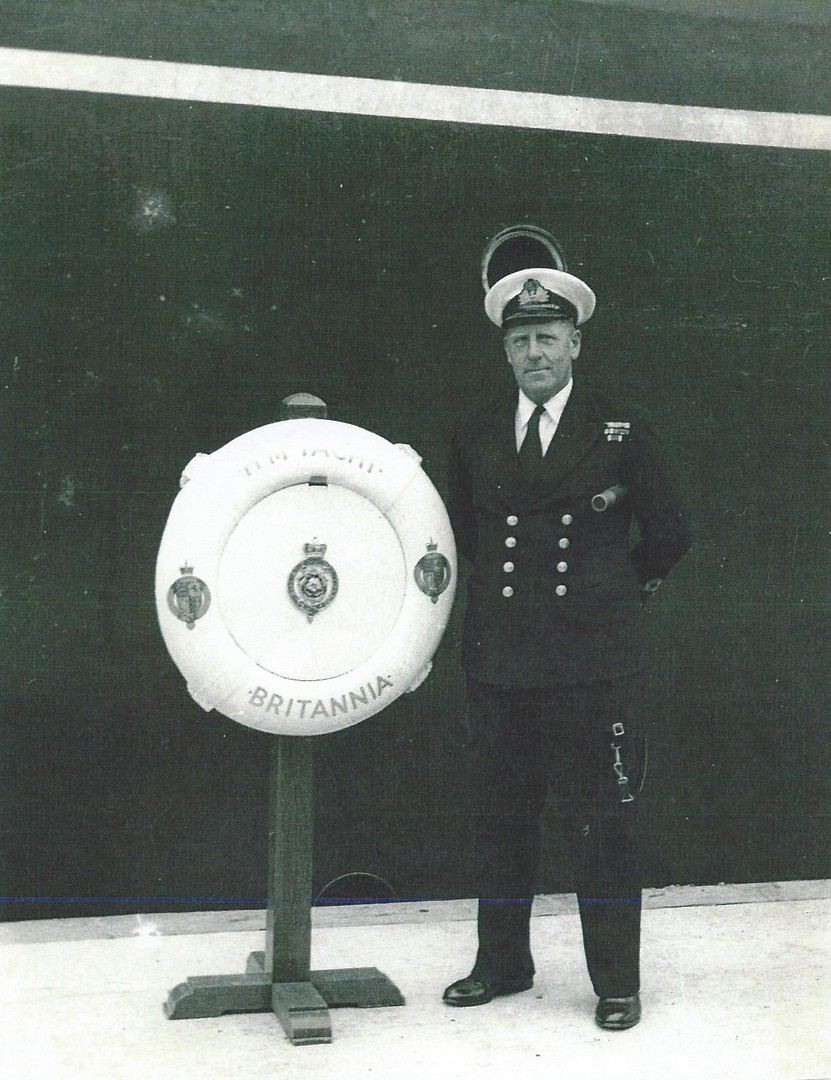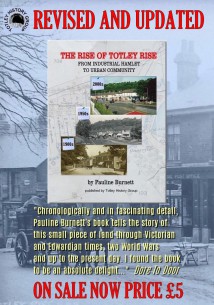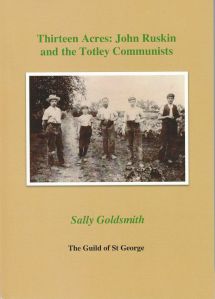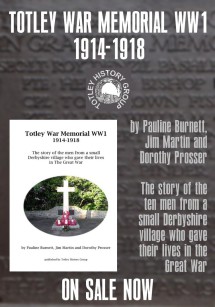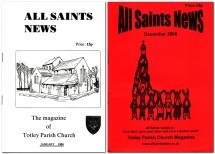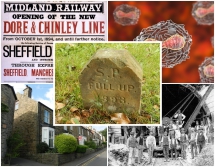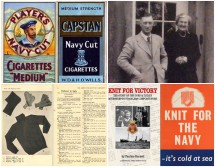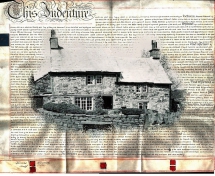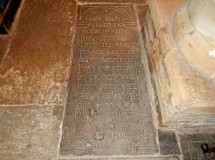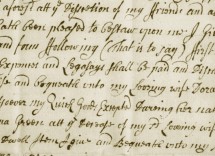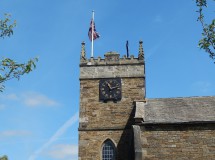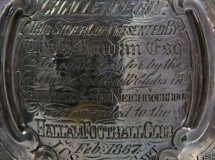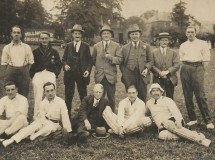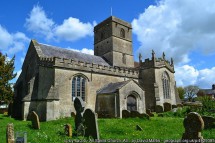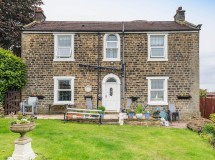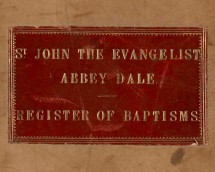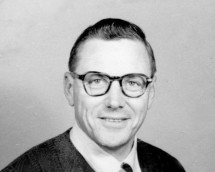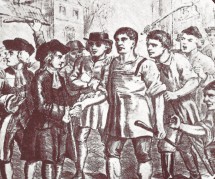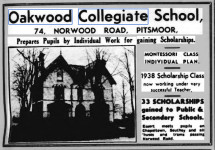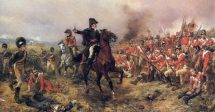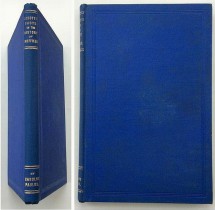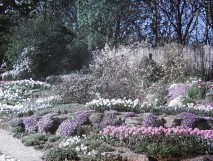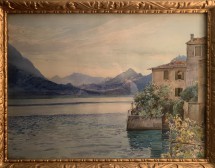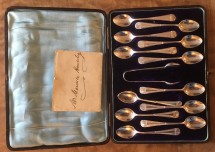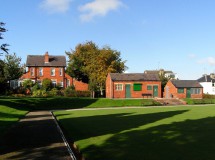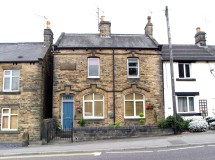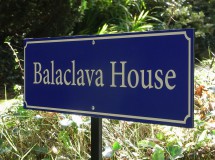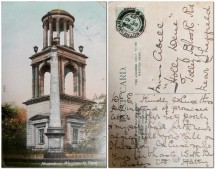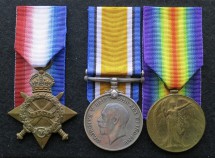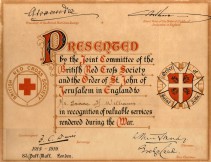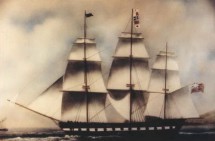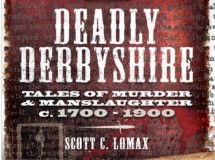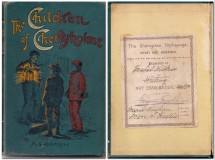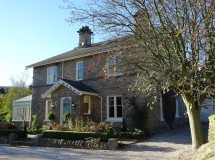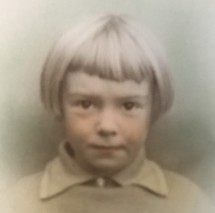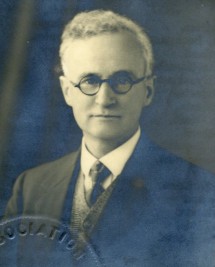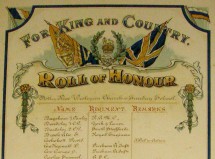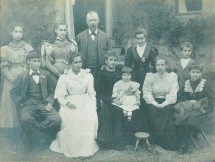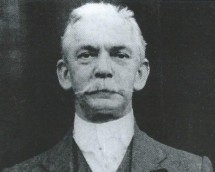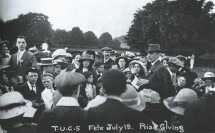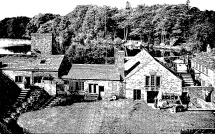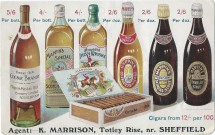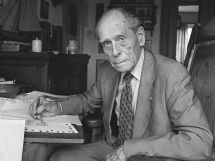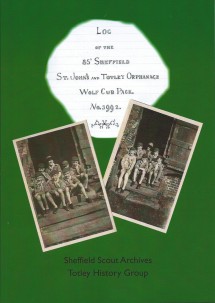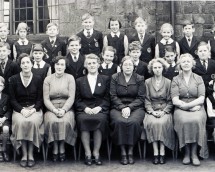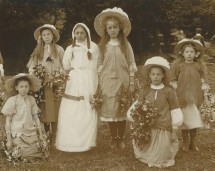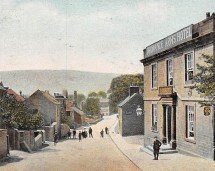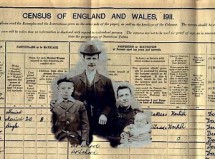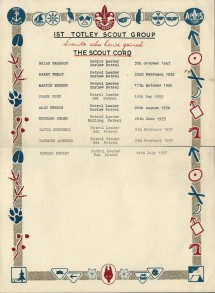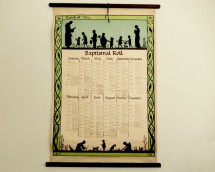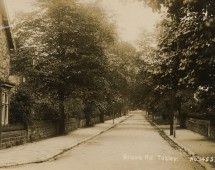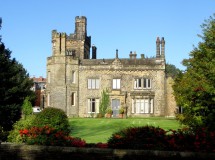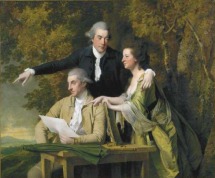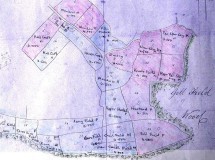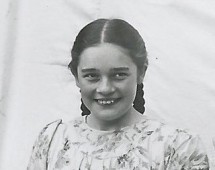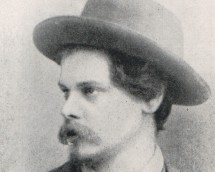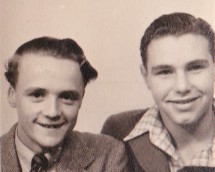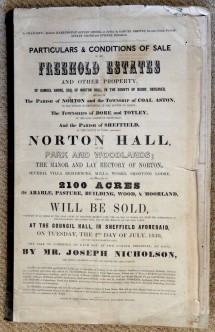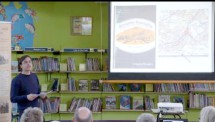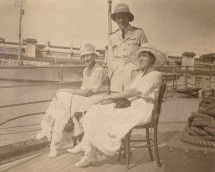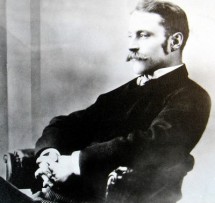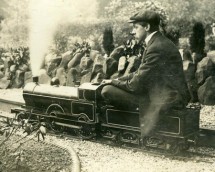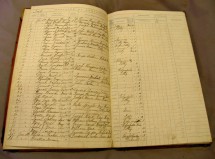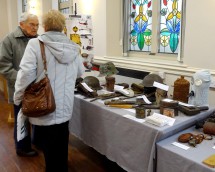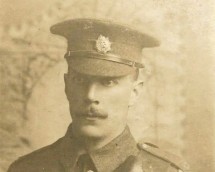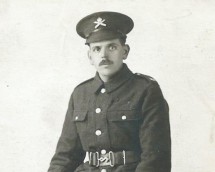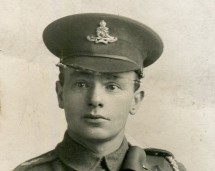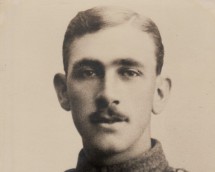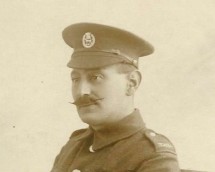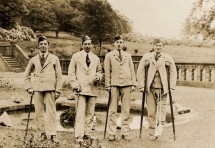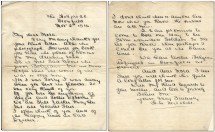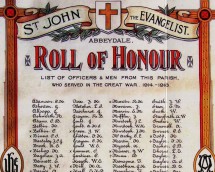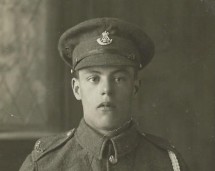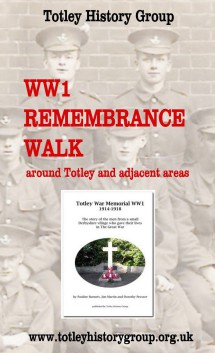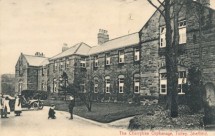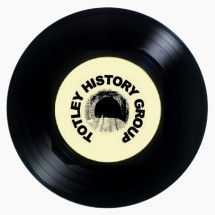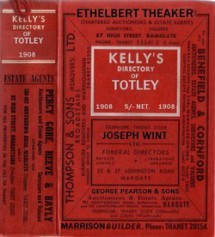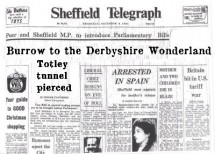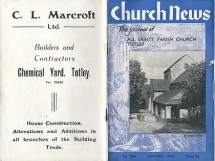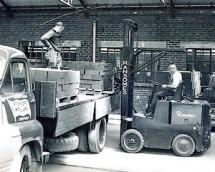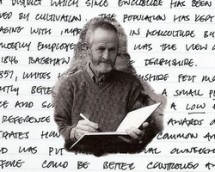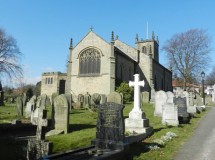Eric C. Hill
A Mixture of Memories (Part 1, Chapter 1)
by Lieut. Cdr. E. C. Hill, M.V.O., R.N.
I was born on 10th June, 1910, in one of a block of four very small terrace houses, then called Brookside Cottages, situated at the foot of Mickley Lane, Totley Rise, near Sheffield. They no longer exist. My parents proceeded to produce four more boys in the next five years, the last child, however, died at birth, together with my mother. She was thirty-one. Father was hurt whilst working at a quarry, sustaining a broken leg and internal injuries. He died within one year of my mother of peritonitis.
I have not been able to gather a clear picture of these early years, despite the fact that our grandparents, numerous aunts and uncles lived within a few miles of our cottage. By the time I was old enough to understand and I became free of the confines of the local orphanage, some of my relations had also died and most details of our early years were lost. The only thing I remember of my mother was of a tall fair lady, wearing a long dress and a frilly white high-necked blouse, standing at a window putting a pad of some description on her head and forming her hair around it. Her hair was very fair. I do remember seeing a four-wheeled vehicle, drawn by two black horses outside the front gate. A long box was being loaded into it. This was likely to be my mother's funeral.
Of my father I remember a little more. After his quarry accident my father's health deteriorated and I was sent to take a note to the doctor's house at Totley Rise, asking him to call quickly. For reasons unknown he could not attend until the following day, which was too late. I was told of this years later, and also that my father's last words were, "My poor boys." He used crutches for a time, but this did not stop him from showing us how to kick a football. Before his accident he had constructed a sledge. This he had hauled to the top of Mickley Lane as far as the old Mickley Pit, a distance of three-quarters of a mile, and brought us all back at break-neck speed to the gate of the cottage. This must have been during the last winter of his life. I, at least, must have been a damned nuisance; I was the only one of a 'gang' of four who was caught rowing a boat on the lake of Brinkburn Grange. I was overtaken by the owner's man. A policeman came to the cottage. My father apparently told him not to be so daft and he departed after seeing the size, and noting the age of the culprit. According to a cousin, anything to hand we threw into the river, chiefly crockery, knives and forks, etc.
Our entry into Cherrytree Orphanage was agreed by the elders of the family who thought it better to keep us all together rather than share us out among the aunts and uncles, who had large families themselves. A tall lady in black took us up the hill to Cherrytree, only a few hundred yards from the cottage. I remember helping to push a 'pram' presumably containing the youngest, 'Leslie', up the lowest part of Mickley Lane. From the moment I remember the pram, life was a complete blank! I can say nothing of events in the Orphanage for an unspecified period of time, possibly two or three years. My mind seems to have commenced recording round 1918 because I can well remember a man running around shouting "War's over", so maybe that is as good a time as any to record what I remember of the Orphanage days from 1918 to 1924.
The staff consisted of a matron, who was a large imposing lady with red hair. Looking back I would now say that she progressed along the corridors like a ship under full sail. Her daughter, Margaret, also red-haired and pretty, appeared at holiday times, so was probably at Boarding School. No man ever appeared on the scene. Their name was Haig.
A second lady, Miss Carr, a mousy little woman, was our teacher. She was a marvel in all respects, because to control twelve boys and thirteen girls, ranging in age from 5 to 14 years was no mean accomplishment. Miss Carr eventually disappeared, and we found ourselves trailing over a mile twice a day to the local school at Totley.
The kitchen staff consisted of a lady who I think was the gardener's wife, who had under her command three senior girls. These girls were over 14 and were retained for training for service with some of the local gentry. One of them, a lass called Sally Horton (as I found out some years later) was actually ear-marked to serve as housekeeper to a Mr and Mrs Hudson who lived in Totley and owned a very popular small restaurant in Sheffield. The gardener had his work cut out because the grounds were extensive and most food was produced by him. He had two boys (one of whom was myself) to dig plots for vegetables, collect leaves in autumn, and stoke the boiler - more of the latter later.
I particularly relished the task of climbing fruit trees in the orchard and collecting fruit for jam-making. The two Victoria plum trees, however, were too much of a temptation and I was quickly relieved of the collecting task. So much for the resident staff and assistants.
Once a month two ladies of the Orphanage Committee paid an official visit. One was a Lady Bingham. They appeared in a beautiful four-wheeled trap, drawn by a couple of splendid horses with a uniformed coachman sat up front. We boys had the privilege of taking turns holding the horse's head reins during the visit. These ladies interviewed the inmates about to leave, plus those of us who had been misbehaving. I regret to say that, later on, I was one of the latter, together with my brother Graham.
Outside the school, the boys' duties included sweeping up the playing areas, tipping coke down the boiler house coke chute, carting rubbish from the kitchen to compost, cleaning lower windows, while the girls changed sheets, cleaned bathrooms, peeled potatoes, washed up dishes, etc. We obviously were not stuffed with food, being War time, but I cannot remember ever being hungry. Bread, porridge, rice pudding, potatoes and spinach formed our staple diet. I hated spinach and just could not eat it, and was punished accordingly - a rap on the head with a wooden spoon! We did, however, find ways and means of supplementing our rations; for instance - some apples were 'keepers' and could be cached in any of the dry stone walls surrounding the establishment; potatoes could be roasted in the boiler house, although it required a certain amount of expertise to slide down and get back up the coke chute, unnoticed, to get at the boiler furnace. A shovel full of spuds placed inside the furnace door was a 'piece of cake'. We had many a barbecue, after the gardener had gone home of course, and the bakes were always meticulously shared out. The potatoes, incidentally, were filched from the farmer's adjoining field, and despite the fact that he (a Mr Wint) noticed bare patches in his field of spuds at the nearest point to the Orphanage boundary, never complained (Bless him).
Few can resist the smell of new bread. The bread room was situated in the first floor adjacent to the communal dining hall and could, we discovered, be entered through a window by means of a
ladder. Because I was the gardener's help I knew where the ladders were kept so was the obvious choice for the bread pinching job. Quite a number of loaves disappeared through the window before the
inevitable happened and I was hauled up before the Matron and subsequently the two Committee ladies. I was threatened with banishment to a school of correction, but this did not happen (This I
learned from Sally some years later).
Sunday, I remember best of all, with porridge for breakfast and rice pudding for lunch. We dressed in our best clothes-boys in Corduroys, boots instead
of clogs, girls in striped gingham dresses (white and blue), and marched to Church, which was St John's, about two miles distant towards Beauchief. A few of us were press-ganged into the choir. After
the mid-day meal (which was invariably rice pudding for the sweet, we were all in turn required to recite the collect of the day, having learned (?) it during the week. This I hated. I just found it
extremely hard to absorb more than three lines of any, and some of those collects are as long as grandfather's recipe for making elderberry wine.
Sunday afternoon found us knitting socks; this was girl's work we boys thought. Nevertheless we did it. Four thin steel needles, and balls of grey wool; always grey wool was in the fists of all who were considered old enough to knit. Incidentally, some sadistic child discovered that a knitting needle tied to the end of a willow or beech branch made a good arrow. I have a scar above my right eye as a result of playing 'Cowboys and Indians'. At teatime a couple of girls collected our knitting efforts in a cardboard box to be kept until the next Sunday, or wet day. It was not uncommon to find one needle pulled out and the onerous job of 'picking up' was necessary.
I cannot remember a Christmas but this was possibly because I did not understand what it was. None of us celebrated birthdays, and I didn't know what money was until one day a man gave me two coins for opening his drive gate, thus saving him the bother of getting out of his car. The local butcher's boy who delivered to the Orphanage, told me what I could get for two pence, and from where. I clearly remember what I bought - two horseshoe creams and a few gob-stoppers. Some days later I visited the same shop (which incidentally is still operating to this day) and walked away with a handful of toffees without paying for them. I just could have had no idea that it was wrong, despite the fact that I had given money in exchange for goodies on my previous shopping spree. However, again I was up before the Matron but cannot remember having to stand shaking before the two awesome-looking Committee ladies.
You will have noticed that I have very seldom mentioned my brothers. Having talked to Graham and Leslie since those days, we none of us knew the meaning of brothers but because we all appeared in
one heap together at the Orphanage, we had a tendency to stick together, but only for that reason. What is more, and very sad, none of us missed our parents. Too young to understand the mystery of
life, no doubt.
Bath nights, I vaguely remember, were boys on Saturday, girls on Friday, and I have not the faintest idea how they were supervised. I do remember that two at a time occupied a bath, that our towels
were numbered and hung on hooks also numbered. In fact we all had a number for almost everything. Mine was thirty-nine, and curiously that number has been with me throughout my life - coincidence, no
doubt - and too many to mention except perhaps one - the start of the Second World War and my service on HMS Sheffield. There was a library in the staff sitting room from which I drew my very first
book. This was The Last Mohican'. I must have liked it because my second was 'Eric, or Little by Little', and I can remember no other, if indeed there had been any.
At some point the Orphanage School was no longer used. On our way to the local one at Totley we discovered that 'someone who knew us' lived only a few steps away off our route. This we learned from an Aunt Ella who on her way to and from her work passed the comer of a rather obscure part of the Orphanage grounds and would look for us occasionally. On these occasions she invariably had a bag of toffee, and did we love her for the present. She was very poor and it must have been a sacrifice. She told us to call at two houses, one where our Aunt Mabel lived, and the other was the house of our grandparents. I have a recollection of the daughter of Aunt Ella taking us to these houses on the first occasion. Phoebe, the daughter and our cousin, was about my age.
From then on until we in turn left the Orphanage, we began to learn something of our origin and family connections. The Matron got to know about our visits, which she frowned on, so we took it in turns to call, and not very often, hoping to escape detection. I personally was to cause more trouble for our Matron before my final departure - next stop Scarborough.
I have previously mentioned the butcher's boy, whose main attraction for me was that he drove a horse and cart. On one of his visits, I begged a ride and proceeded to fall off after travelling only a few yards, and sustained a dislocated elbow. This accident shaped my future because a Dr Mary Andrews was called in to deal with it. She was obviously given a vivid account of my misdemeanours and on my recovery, decided to 'take me in hand'.
Her decision caused a revolution of sorts at the Orphanage; the first effort being a request to the Committee to allow me to join her Boy Scout group,
the 85th Sheffield group, operating on Thursday nights from her own house at Beauchief. As boys became eligible they too joined and included Leslie, Cecil and Graham. In the meantime Dr Mary
convinced Matron that swimming was the best method of getting my arm working again, so down to the swimming baths I went. I calculate that at this time I was in my thirteenth year and after being
escorted to the baths once or twice, went on my own.
By the time I left the Orphanage I could swim very well and this was to give me a great advantage on joining the RN some two years later. Dr Mary, I think, paid the swimming fees and I think supplied the Scout uniform. It was during my Scouting period (in my fourteenth year) that she took her troop to Filey on a camping exercise. It was a great time for me. The Filey cobbles (sturdy open-decked boats) - used for fishing parties chiefly -fascinated me. I was allowed to steer one and from that moment was hooked to the sea. Dr Mary noticed this, and to cut a long story short, arranged for me to go to the Sea Training School at Scarborough prior to joining the Royal Navy when I became old enough - i.e., fifteen and a quarter years.
Before I close this chapter, a few more words about these formative years at Cherrytree will not, I think, come amiss.
I now think that the decision to keep us together was a good one. The Orphanage must have been a cut above the average. We were cared for, taught to look after ourselves and, above all, experienced discipline which paid enormous dividends when I joined the Royal Navy and my brothers the Merchant Service. During our stay we learned a little of our relatives, but as we lads all virtually disappeared at the age of fourteen, we had not sufficient time to get to know them better. Although love and affection was, to us, an unknown quantity, what one hasn't had one doesn't miss - until a few more years had rolled by anyway.
I cannot remember anything of the actual process of leaving. How I got to Scarborough, how I was dressed, and amazingly, my introduction to train travel. I don't think that I knew where in fact I was bound. Dr Mary, no doubt, was my escort for I later found out that she arranged my lodgings and entry into the Maisie Graham Sea Training School - a day school run by the local Education Authority.
So ended the first fourteen years of my existence - and the sea beckoned.
I never saw my brother Cecil again, and only met up with Graham and Leslie twice until 1980 when we had a Hills' reunion party in Sheffield.
Cousin Eric Hill (after Cherrytree)
taken from his autobiography "A Mixture of Memories"
When Eric and his three brothers were receiving help from Dr Mary Andrews she took them to her scout camp at Filey. It is worth while reading her account of these adventures in her booklet 'Oh! Little Filey'. During these camps he was introduced to the Filey fishing vessels which are called cobles. Dr Andrews noticed how keen Eric seemed to be on these small open boats and interpreted this as being an interest in the sea in general. To that end she assumed command of his career upon him leaving the orphanage.
The following is a brief summary of how he climbed from being a 'Boy - 2nd Class' to Lieut. Cdr. E. C. Hill, MVO, Royal Navy. He only encountered two impediments along the way. The first, which Dr Andrews removed, which was when he wanted to leave the service; and the second when he had to take measures to make good his lack of secondary education in mathematics in order to receive a commission.
Before starting his career proper in the Royal Navy Dr Mary arranged for him to attend the Graham Sea Training School at Scarborough. He took to this with relish and particularly enjoyed sailing in a sloop called Bonaventure and a schooner named Maisie Graham. All his spare time was taken up by doing unpaid voluntary work on maintaining these boats after Dr Mary had signed papers exonerating the owners from any liabilities regarding possible accidents. The Master of the school allowed Eric and another boy to sail his own yacht 'Cymbeline' in the Bridlington Regatta of 1925. This was the highlight of this formative period of his life. In October of this same year Dr Mary took him to Manchester to enrol in the Royal Navy. After a bath with carbolic soap and the burning of his clothes he was fitted with a uniform which, in different guises, he was to wear for just short of 50 years.
At this early stage of his training he established himself as goalkeeper in the football team, a place in the 'tug of war' team and a keen rower. These activities added to the strenuous and nationally watched field gun competition, held at Earl's Court, filled a great deal of his time.
Eric did not suffer homesickness as did the other boys and he very much enjoyed all the introductory training. His first leave was spent at Dr Mary's where he helped her clear out as she was closing her practice. He returned to start his sea training on HMS Benbow. He learned the art of tying knots, splicing and boatwork. He also found out that the more serious misdemeanours were punished by receiving 'cuts'. After being medically examined they were secured to the gym 'box' and caned by a petty Officer.
Eric started his career as a 'sight setter' for one of the 6" guns. After 8 months on Benbow becoming familiar with all the necessary duties around the clock he was given a white uniform and drafted to HMS Valiant based at Malta. On her he found himself in the presence of mainly adult sailors. The fleet was engaged in all the activities to prepare for war. These included escorting convoys around the Mediterranean, landing guns and marines, bombardment of an unoccupied island and ship towing. On 10th June Eric was automatically promoted to Ordinary seaman thus becoming a 'man'.
Another leave helped him to discover that Graham and Cecil were in a training ship 'Conway' at Birkenhead on the first stages of their progress to be captains of Merchantmen and Leslie was still at the Maisie Graham at Scarborough.
As a crew member of HMS Canterbury with the Home Fleet, I made a friend who invited me to spend a series of long leaves with his family. This was the first time that I experienced what it was like to share time with a mother and sisters. Regular changes of ship, visits to Scapa Flow and an extensive sporting programme became the norm for Eric as he made the necessary climb up the promotion ladder. At this time he made an allowance of 5sh a week (Half his wage) to his grandparents who were trying to live on the OAP 'wage' of 10 shillings a week. (I remember my mother saying that, frequently, there was nothing left after the men in the family horticultural business had been paid - these were the days of the Great Depression).
Eric proceeded with his training in Gunnery, pursued his activities with a serious 'tug-of war' team up to the AAA finals and sailed in 1932 in the Ardent with the 3rd destroyer flotilla of the Mediterranean fleet. Back home again he was to play a leading part in the Royal Tournament at Olympia in the Field Gun Crew races. A home leave saw him meeting his wife to be, Alma, at a dance at Green Oak before, after getting engaged, he went on a three year service with the China Fleet. In 1937 Eric was confirmed in the position of Petty Officer which gave him much more responsibility. He also thought, almost absent mindedly whether or not he was passing his brothers as they sailed the oceans. After his marriage to Alma in 1938 Eric received his next draft and joined HMS Sheffield in October 1939.
His experiences in HMS Sheffield were extraordinary. It was the first ship to fire at a German target in the war. It escorted Lord Mountbatten back home in his damaged ship. It conducted many escort duties into the Arctic Seas, it played a major role in the sinking of the Bismark. It escorted the Empire Trooper to Gibraltar after it had been damaged. It turned out to be his brother Leslie's ship. It carried an early form of Radar. It assisted in the Salerno landings and took American troops to the North African theatre.
It is quite obvious that Eric conducted himself with commendable bravery during his six years on board HMS Sheffield with him being mentioned in dispatches. He witnessed a great deal of damage to his ship. Nearing the end of hostilities, he left the destroyer and proceeded to qualify for commissioned rank with the help of an RAF schoolmaster specialising in mathematics.
For some ten years he held various positions as a Naval Officer before, in 1955, gaining the post of Boatswain on the Royal Yacht Britannia. Invitations to Pauline and me to visit the ship when the Royal family were not in occupation were turned down because of the daily responsibilities of our nurseries.
Eric's time on the Britannia included the voyage round the world with the Duke of Edinburgh and visits to many countries. He, along with the Duke and senior officers, wore beards for the duration of the voyage. When in Australia for the Olympic Games Eric saw cousin Sam Pinder (See Albert Pinder - Totley Independent). After his maximum time on the Britannia he was given the award of MVO - Member of the Royal Victorian Order which is at the sole discretion of the Queen - in 1958. I am sure that Eric could have written a book solely on his time on the Royal Yacht. He received the promotion to Lieutenant Commander.
Alma died in 1960 but Eric received much support from his daughter Pat. In 1963 Eric married Jean who hailed from Scotland. With the help of cousin Victor, Eric organised a gathering in Sheffield of many of his friends and relatives in 1980. At the funeral of my mother in 1989 the same Victor arranged with my son Simon to have a similar gathering but to include members of the younger generation. Sadly Victor died before their plans reached fruition.
Michael Hill
Search Our Website Here
September
October
November
Unless stated otherwise our meetings are held in Totley Library on the 4th Wednesday of each month at 7.30pm.
Pauline Burnett's book The Rise of Totley Rise has been revised and updated. It tells the story of this small piece of land from 1875 when there was only a rolling mill and chemical yard alongside the river a mile from Totley, through Victorian and Edwardian times, two world wars and up to the present day. It has 94 pages including a useful index and many illustrations from private collections. The book is available now from Totley Rise Post Office priced at £5, or through our website when an additional charge will be made to cover packing and postage.
A few copies are still available of Sally Goldsmith's book Thirteen Acres: John Ruskin and the Totley Communists. Totley was the site of a utopian scheme funded by art critic and social reformer John Ruskin. In 1877 he bought 13-acre St. George’s Farm so that nine Sheffield working men and their families could work the land and, to keep themselves busy, make boots and shoes. Sally tells an engaging story from our history with a quirky cast of characters including Ruskin himself, the poet and gay rights activist Edward Carpenter and Henry Swan, a cycling, vegetarian artist and Quaker. The book is available to order online from the The Guild of St. George by following this link.
A recently discovered box of WWII correspondence reveals the story of how a small group of ladies from Dore and Totley recruited knitters from the west of Sheffield and how their efforts made them the country's greatest provider of Comforts for the Minesweeping crews of the Royal Navy. The story is told in Knit For Victory, a new book from Totley History Group. Written by Pauline Burnett, it has 82 pages and many illustrations. It is on sale in local shops and via our website. Further information about the correspondence is in this inside page of our website: Dore & Totley Minesweeping Trawlers Comforts Fund.
The story is told in Totley War Memorial WW1 of the ten men from our village who gave their lives in the Great War. Written by Pauline Burnett, Jim Martin and Dorothy Prosser, a chapter is devoted to each of the soldiers with a family tree followed by as much information as could be discovered about the men and their families. There is also information about their military careers and the actions in which they lost their lives. The book has 64 pages and is illustrated throughout with photographs of the men, their families and the houses where they lived.
Totley All Saints' Church Parish Magazines for the years 1985-2006 with notices of baptisms, marriages and funerals and accounts of spiritual, educational, charitable and social matters in the village. Scanned in full, including advertisements from local traders.
In 1893 during the building of the Totley Tunnel there was an outbreak of smallpox amongst the navvies which spread to some of the local population. 17 people were buried in communal graves in Dore Churchyard, 6 from "Green Oak" (Lemont Road). The severity of the outbreak was principally caused by overcrowding and insanitary conditions in lodging houses .
Kathleen Grayson was a 39 year old housewife when WW2 broke out. She volunteered for the ARP and became an ambulance driver. During an air raid on Sheffield in July 1941, and despite her own injuries, she managed to get a seriously injured casualty to hospital. For this she was awarded a commendation from King George VI. Together with her friend Hilda Duffy, Kathleen also assembled a team of knitters to provide essential warm clothing for the men serving on the minesweepers patrolling the North Sea.
We have recently bought at auction the WW2 memorabilia of Douglas Platts whose family home was at Hillside, 98 Queen Victoria Road. After the war Douglas returned to his civilian occupation working in the family scissors manufacturing business. He lived in our area for the rest of his life.
We are very grateful to Mrs Valerie Taylor of Dore for lending us the title deeds to Lower Bents Farmhouse which is reputed to be the oldest surviving building in the area with a proven history back to 1621. We have now scanned and transcribed the deeds which could be particularly interesting to anyone with a connection to the local Fisher, Dalton and Marshall Families.
Until 1844, when Dore Christ Church parish was created, Totley township was part of Dronfield parish. We have now transcribed the burial records for former Totley residents at St. John the Baptist, Dronfield for the period 1678-1870 and at St. Swithin, Holmesfield for the period 1766-1901.
Whilst researching the history of the Dalton Family we found it useful to transcribe a number of early Wills and Inventories. These and those of many other Totley, Dore and Holmesfield people dating from between 1594 and 1856 have now been added to our website.
St. Swithin's Church, Holmesfield pre-dates Dore Christ Church and was the place where many of the people from Totley worshipped and were baptised, married and buried. Read the inscriptions on more than 750 gravestones in the churchyard including those of Mr. and Mrs. William Aldam Milner of Totley Hall, Jessie Matilda Tyzack (nee Fisher) of Avenue Farm, and Rev. J. A. Kerfoot of St. John's, Abbeydale.
Thomas Youdan was a music hall proprietor and benefactor who was living at Grove House, Totley in 1867 when he sponsored the first football knockout competition in the world for The Youdan Cup.
The words Millhouses Cricket Club can be seen in the background of team photos which are likely to date from between 1905 and the early 1920s, very probably pre-war. They were lent to us by Garth Inman who can identify his great uncle, Cecil Inman, in some of the photos and would like to know when they were taken and, if possible, the names of others present. Please take a look to see whether you can put names to any of the faces.
Josiah Hibberd was seriously injured whilst working on the construction of the Totley Tunnel in 1892. He died on 9 May 1897 at the age of 38 having apparently spent most of previous five years in hospital.
Bradway House was built around 1832 by Henry Greaves, a farmer, together with two adjacent cottages. We have traced most of the occupants of the property from these early days up to the start of World War Two.
We have transcribed the baptisms records at St. John the Evangelist, Abbeydale from when the church was consecrated in 1876 until just after the start of World War 1. The records are arranged in alphabetical order based upon the child's name and show the date of baptism, the names of the parents, their home location and occupation.
Nick Kuhn bought an original 1920s poster which had this owners' blind stamp in one corner. The stamp almost certainly refers to a house named Wigmore that was built in the late 1920s or early 1930s. The first occupiers that we can trace are John Howarth Caine, a district mineral agent for the LNER, his wife Florence Jane (nee Prince) and daughter Doris Mary. The Caine family lived at Wigmore until 1936 by which time the house would have been known simply as 12 The Quandrant.
George Griffiths died on 13 December 1888 following an explosion during the sinking of number 3 airshaft at Totley Bents. His widow Florence died shortly afterwards and his two daughters Maud and Annie were adopted separately. Whilst Annie lived the rest of her life in Yorkshire, Maud emigrated to Australia in 1923 with her husband, John Burrows, daughter Margaret and son Jack, pictured above.
George Wainwright was said to have been born in Bamford, Derbyshire in 1714. He learned the trade of linen weaving and moved to Totley after his marriage on 1744. He became an ardent follower of John Wesley who paid many visits to Sheffield and who would have passed through or close to Totley. Preaching was at first conducted out of doors and when Wesley's preachers became harassed by a mob of Totley ruffians in 1760, George offered them safety of his own home. He remained a Methodist for all of his long life, dying in Dore in 1821 at the reputed age of 107.
Oakwood School was started by Mrs Phoebe Holroyd in 1925 initially as the Firth Park Kindergarten and, by 1927, as the Firth Park Preparatory School. Phoebe was still working at the school almost fifty years later when she was well into her seventies. We would like to hear from anyone with memories of the school.
James Curtis was born at sea aboard HMS Chichester in 1790. He enlisted as a Private in the 1st Grenadier Regiment of Foot Guards in Sheffield in 1812 and served in Spain and Portugal during the Peninsular War. He later fought in France and Belgium taking part in the Battle of Waterloo. In later life James lived at the Cricket Inn where his son-in-law William Anthony was the licensed victualler. He died in Heeley in 1882 aged about 91.
Charles Paul lived in Totley in later life. He was a local historian and archaeologist who was an authority on the history of Sheffield, especially the two areas he knew best: Attercliffe and Ecclesall. His books and letters to local newspapers were published under the Latin form of his name Carolus Paulus.
Towards the end of the 19th century Totley Hall gardens became a well known beauty spot that attracted many hundreds of visitors from Sheffield on open days and the rock gardens became one of its most popular features. Mrs Annie Charlesworth sent us six glass transparencies of the rock gardens taken, we believe, in the early years following the Great War.
Anton Rodgers send us photographs of three water-colours that had been bought by his grandfather at a sale of the contents of Abbeydale Hall in 1919. One was of a scene said to be in York by A. Wilson. A second was of a seated child with a dog believed to be pianted by Juliana Russell (1841-1898). The third was of Lake Como, by Ainslie Hodson Bean (1851-1918) who lived for much of his life on the Riviera and in North Italy.
A Canadian correspondent sent us photographs of a set of silver spoons that were bought in a small town in British Columbia. The case contained a note signed by Ebenezer Hall indicating that they were a wedding gift to Maurice and Fanny Housley. We think we may have traced how they got to Canada and where they might have been since.
Green Oak Park was opened on 23 March 1929 on land that had been bought by Norton District Council from John Thomas Carr, a farmer and smallholder of Mona Villas. In later years, the buildings were used by the Bowling Club (the green having been built in 1956) and by the park keeper. However, the buildings appear to have been constructed in several phases, the oldest of which predates the park to the time when the land was used for pasture.
We believe the old Totley Police Station at 331 Baslow Road was built around 1882. Two lock-up cells were excavated just below floor level in the summer of 1890. We have traced the Derbyshire Constabulary police officers who lived there from John Burford in 1886 to George Thomas Wood who was there when Totley was absorbed into Sheffield in 1934.
David Stanley lived in Totley Rise in the later years of his life. Born in Bulwell, Nottinghamshire, he joined the 17th Lancers when he was 19 and rode in the Charge of The Light Brigade at the Battle of Balaclava where he was seriously wounded. For the first reunion of veterans in 1875, he told his story to a reporter from the Buxton Herald.
This picture postcard was addressed to Miss Abell, Holly Dene, Totley Brook Road and posted in Rotherham on 10 December 1907. Edith Annie Abell was born on 4 February 1887 in Sheffield and her family came to live in our area in the 1900s, staying for the rest of their lives.
Charles Herbert Nunn enlisted in the British Army on 23 August 1915 and was sent to France on 18 December 1915 to served with the British Expeditionary Force. In March 1916 it was discovered that he was underage and he was returned home. Shortly after his 18th birthday he re-enlisted and was again posted abroad where, in addition to this trio of medals, he was awarded the Military Medal.
This certificate was awarded jointly by the Red Cross and St. John's Ambulance to Isaac Henry Williams, of Lemont Road, for his services during WW1 as a stretcher bearer. We are seeking anyone who can help us pass it on to a living relative.
In 1832 Samuel Dean pleaded guilty to stealing a quantity of lead from the Totley Rolling Mill and was sentenced to seven years transportation to Australia. He sailed on the Mangles and upon arrival in New South Wales he was sent to work for William Cox, the famous English explorer and pioneer. After receiving his Certificate of Freedom in 1840, Samuel became a farmer and went on to have a very large family. Samuel was born in Whitechapel around 1811 to parents Samuel Dean Snr. and Susannah Duck. His descendant Sarah Dean would like help in tracing his ancestry.
Ellen Topham was born in 1889 in Nottingham. Her parents had been living together since 1862 but had never married so it was most unusual that, after their deaths, Ellen was accepted into Cherrytree Orphanage. Even more so since her father, Snowden Topham, had been acquitted somewhat unexpectedly in a widely reported manslaughter trial. Ellen remained at Cherrytree until her death from pulmonary tuberculosis at the age of 15.
Mabel Wilkes was a resident in Cherrytree Orphanage between 1897 and 1905. Her granddaughter Sally Knights sent us these images of a book presented to Mabel as a prize for her writing. Sally also sent us some personal memories of her grandmother and a photograph of a locket which contains portraits of Mabel and her husband Septimus Gale.
John Henry Manby Keighley was living at Avenue Farm when he enlisted in 1916. He fought in France with the Cheshire Regiment but after home leave in early 1918 he went missing. The Army were unable to determine whether he had deserted or returned to the front and been either killed or captured by the enemy. In August 1919 he was formally presumed killed in action but it appears he did not die but returned home to his family.
Horace Ford was admitted to Cherrytree Orphanage on 26 October 1888 at the age of six. He left at the age of 14 to become an apprentice blacksmith and farrier. Soon after his 18th birthday Horace enlisted in the Imperial Yeomanry to serve his country in the war in South Africa. His letter home to his Orphanage mentor tells of the lucky escape he had in battle.
Pat Skidmore (née Sampy) lived on Totley Brook Road from 1932 to 1948 before her family moved to Main Avenue. In this short article she remembers her time at Totley All Saints School where she was a contemporary of Eric Renshaw and Bob Carr.
As we have nowhere to exhibit memorabilia and artifacts, we have created a Virtual Museum instead. The latest addition to our collection is this double-sided Totley Rise Post Office oval illuminated sign which was on the wall of 67 Baslow Road before the Post Office business transferred to number 71. Please contact us by email if you have things that you own and would like to see added to the virtual museum.
Conway Plumbe was a man of many talents who came to live in Totley Rise around 1912. As a young man he had poems published by Punch magazine and is remembered in modern collections of WW1 poetry. A number of his paintings were accepted by the Royal Academy. An engineering graduate of London University, he joined the Civil Service where he rose to a high level as a factory inspector, publishing two books on the subject and giving a series of talks on workplace health and safety on BBC radio during WW2. In retirement he wrote a philosophical-spiritual work called Release From Time.
Inside Totley Rise Methodist Church there is a Roll of Honour commemorating the soldiers from its congregation who served their king and country during the Great War. For all but one of the 28 names the soldier's regiment is recorded in the next column. The exception is David Cockshott for whom 'killed in action' is written alongside yet he appears on no war memorial in our area and no record of a mortally wounded soldier of that name is to be found. We think we have solved the mystery.
Mrs. Kate Plumbe moved from Mansfield to Totley Rise with a number of her family in 1913 and became closely involved with the Totley Union Church. Her daughter Winifred became a missionary and headmistress in Calcutta for over 38 years following which she returned home to live with her sister Hilda on Furniss Avenue. Hilda had also been a teacher, missionary and, like her mother, a volunteer at St. John's VAD during WW1.
Thomas Glossop was a cutler and razor manufacturer who was well known amongst cricketing and gardening circles. Despite going blind, he was able to continue his hobbies with remarkable success
The Totley Union Cycling Society Prize Giving and Fete was held on the fields near Abbeydale Hall on 18 July 1914. Anne Rafferty and Gordon Wainwright have named some of the people in two wonderful photographs of the event. Can you identify any more for us?
The Tyzack family are well known in our area for owning iron and steel trades at Walk Mill, Abbeydale Works, Totley Rolling Mill and Totley Forge. This article covers the history of the family from the late 18th century when William Tyzack the founder of the company was born until the early 20th century when Joshua Tyzack farmed at Avenue Farm, Dore.
Walter Waller Marrison moved to Totley around 1897 with his wife and their two young sons. He was a house builder who constructed properties around Totley Brook and Greenoak before ill health forced him to take up less physically demanding work. In 1904 he took over the tenancy of the grocers and off licence at number 71 Baslow Road. After his death in 1908, his widow Kate and later their eldest son Jack continued to run the business until it was sold in 1934.
Ron Wijk of Nieuw-Vennep in the Netherlands has sent us two scanned images of drawings of old cottages made by the celebrated Dutch painter, Anton Pieck (1895-1987) simply annotated "Totley", and wondered whether we could identify their locations.
We would like to thank Christopher Rodgers for bringing to our attention this fascinating log of the 85th Sheffield (St. John's and Totley Orphanage) Wolf Cub Pack for 1927-45. The log is published jointly by Sheffield Scout Archives and Totley History Group as a free PDF download. It is illustrated by no fewer than 92 photographs and is supported by a comprehensive index and biographies of some of the main participants.
Following our Open Meeting event on School Days, Roger Hart, Howard Adams and John Timperley have each written to us with their memories of Norwood School, which was located in the rooms attached to the Dore & Totley United Reformed Church on Totley Brook Road.
On 22nd July 1909 the children of Dore and Totley Schools celebrated by a pageant the union of England under King Ecgbert which took place at Dore in AD 827. The pageant was devised and written by Mrs Sarah Milner and her daughter Marjorie and performed in a field close to Avenue Farm in front of a large audience. Photographs of the event survive together with a fragment of the script.
John Edward Greenwood Pinder had lived all 46 years of his life in Totley but on census night, Sunday 2 April 1911, he was not at home; he was in Derby Gaol serving a sentence of three months hard labour. From the age of 20, John had been in and out of local courts for a series of minor offences including drunkenness, assault, wilful damage and night poaching. Finally he was sent to gaol for cutting down and stealing 86 small trees which he sold in Sheffield market for Christmas.
We have already transcribed the census returns for Totley, Totley Rise and Dore. Now we have transcribed Census Strays. These are people who were born in Totley but are missing from our earlier transcriptions. They may have been living, working or studying elsewhere or just away from home on the night the census was taken. Two people were in prison. Others were in Union Workhouses, hospitals and asylums. Fully indexed strays from the 1851, 1861, 1881, 1891, 1901 and 1911 censuses are available now.
We wish to thank Gillian Walker for allowing us to digitize an archive of material about the 1st Totley Scout Group. Most of the material was collected by Arthur Percival Birley in the period 1949-51 and there are many interesting documents pertaining to the building of the scout hut on Totley Hall Lane. In addition four Newsletters survive, two from the 1940s and two from 1971.
We are grateful to Angela Waite and All Saints' Parish Church for giving us access to baptismal and kindergarten birthday rolls dating from 1926 to 1941. We have transcribed the names, addresses, birthdates and baptismal dates and created an alphabetical index of entries for you to search.
Edmund Sanderson, a Sheffield estate agent, aquired the land on either side of the old drive to Totley Grove in 1874 and divided it into plots for development. He called it the Totley Brook Estate. But before many houses were built, the estate road was severed in two by the building of the Dore & Chinley Railway line. The eastern end of the road became the cul-de-sac we now call Grove Road.
John Roberts was born in Sheffield in 1798. He became a partner in one of the leading silversmiths firms in the city before moving to Abbeydale Park in 1851 and extending the house in Victorian gothic style. He paid for the building of St. John's Church and was believed to dispense more in charity than any other person in the neighbourhood including his protege Ebenezer Hall.
The Coke Family owned the Totley Hall Estate from 1791 to 1881. With the aid of a family tree to guide us, Josie Dunsmore takes us through the story of their tenure.
When the Rev. D'Ewes Coke inherited the Totley Hall Estate in 1791 it had two farms. Josie Dunsmore tells the story of how the two farms were combined under the tenancy of Peter Flint with the aid of field maps drawn by Flint himself and later by the Fairbanks family.
Do you think you recognize this face? More than sixty photographs of the girls and teachers at Hurlfield Grammar School for Girls in the 1940s were given to Totley History Group by Avril Critchley, who was herself a student at the school. The collection includes fifteen form photographs from June 1949. There would have been a number of girls from the Totley area attending the school in those days.
Christine Weaving tells the story of her 2 x great uncle George Edward Hukin, a Totley razor-grinder, and his life-long friendship with the academic, poet, writer, and free-thinker Edward Carpenter.
Eric Renshaw (pictured here on the right with Bob Carr) grew up and lived in Totley from 1932 to 1960. Many of his memories are of a sporting nature.
We are very grateful to Gordon Grayson for giving us this splendid sale document for the Norton Hall Estates, following the death in 1850 of Samuel Shore. The estates included a large part of Totley and the document has maps and illustrations, plus schedules of land and property with the names of tenants. We have also added a transcription of the entries for Totley and Dore.
Watch this Youtube video of the talk given by Dr. Mark Frost and Sally Goldsmith on Ruskin, Totley and St. George's Farm. The talk was hosted by Totley History Group on 20th May 2015 as part of the Ruskin in Sheffield programme. Also enjoy a video of the outdoor performance Boots, Fresh Air & Ginger Beer written by Sally.
When Jacqueline A. Gibbons became interested in what made her father tick, it began a journey through WW1 archive records and led to her flying from Toronto to visit the house and village where he lived and the countryside that he so much enjoyed. Jacqueline reminds us that in the early 20th century Sheffield was a driving force of industry and that Totley was the place where many of its remarkable people lived and where they formulated their ideas.
Edgar Wood was the designer of The Dingle, 172 Prospect Road, built in 1904 for Rev. William Blackshaw, the founder of the Croft House Settlement. The house, together with its western terrace and boundary walls, has now been awarded Grade II listed building status.
What was probably "the most perfect little garden railway in existence" in 1910 was to be found in the grounds of Brook House, Grove Road, the home of its designer and constructor, Guy Mitchell. Look at some wonderful photographs and read reports in newspapers and a full appreciation in Model Railways magazine.
We have now completed our transcription of Totley School's Admission Records for the period from 1877 to 1914. There is also a useful index to the names of the scholars and to their parents or guardians. We are very grateful to Sheffield Archives and Local Studies Library for allowing us to transcribe and publish these records and for permission to reproduce the photograph of a specimen page of the register.
On 8, 9 and 11 November 2014 Totley History Group held an exhibition at Dore & Totley United Reformed Church to commemorate the centenary of the First World War. Below are additional links to some of the photographs we were lent and stories we researched especially for the exhibition.
Oscar Creswick was a local farmer who served with the Army Service Corps in Salonika and who after the war returned to Totley to become the innkeeper of the Cricket Inn and a member of the village's successful tug of war team.
Walter Evans was a market gardener who also ran a small grocery shop on Hillfoot Road when war broke out. He fought with the Machine Gun Corps at the fourth battle of Ypres. After the war, Walter ran a grocers shop at the top of Main Avenue.
Fred Cartwright was another Totley soldier who survived the Great War. He fought in France and Belgium and although he wasn't wounded he was gassed and was home on sick leave when his daughter was delivered by Nurse Jessop during a snowstorm in January 1917.
Maurice Johnson joined the Yorkshire Dragoons, a territorial unit, on 1 Jan 1914 and so was called up at the very start of the war. He fought throughout the war on the Somme, at Ypres and at Cambrai. After demobilization in 1919 Maurice returned to his old occupation in the steel industry.
Bill Glossop lent us a letter written by his father, William Walton Glossop to his wife describing life in the army during training in the north east of England and asking her to keep him in mind with the children.
The photo above provides a link to an album of photographs taken of WW1 Hospitals at St. John's, Abbeydale and the Longshaw Estate.
Nora Green, of Chapel Lane, was only 14 when war broke out. In 1914 she was ill with diphtheria and was sent to the isolation hospital at Holmley Lane, Dronfield. Nora recovered and wrote a letter of thanks to one of the hospital staff and the reply she received survives.
We have collected together on this page the names of local men who appear on various War Memorials and Rolls of Honour in Totley, Dore, Abbeydale, Norton, Holmesfield and Dronfield.
Unfortunately we were unable to identify all the photographs we were lent of Totley Soldiers. Please take a look at this album to see if you recognize any of the missing names.
This walk visits locations that have strong associations with Totley during the First World War. It includes the homes of the ten soldiers from the village who lost their lives, the auxiliary hospitals, war memorials, and even the rifle range on which the soldiers trained. Take a look at the first draft of a new walk by the authors of "Totley War Memorial WW1 1914-1918"
We wish to thank the Trustees of Cherrytree for giving us permission to publish transcriptions of the Cherrytree Orphanage Admissions Book entries for the years 1866-1929. There is also an alphabetical index for you to look at.
With more people having access to faster broadband and mobile networks, we have uploaded seven full and unedited oral history recordings and also added more short excerpts for you to listen to.
Our transcriptions of local trade directories have been expanded to cover the 95 years from 1837-1932 and have also been indexed. From the days when there were a handful of farmers, stone masons, saw handle makers & scythe grinders to the wonders of the Totley Bridge Garage Company, Betty's Boudoir and The Heatherfield Shopping Centre.
We continue to add to our Totley Newspaper Archive. Recent entries have included several about The Plumbe Family, Thomas Glossop and accidents during the construction of Totley Tunnel.
Totley Church of England Parish Magazines for the years 1922-1939 and 1948-1967 with notices of births, marriages and deaths and accounts of spiritual, educational, charitable and social matters in the village.
Around 90 photographs taken by Stuart Greenhoff for his thesis A Geographical Study of Dore and Totley including several of Totley Moor Brickworks. Superb!
Chronologically ordered snippets of information recorded by Brian Edwards during his many years of research into our local history.
Read the inscriptions on more than 700 gravestones in the churchyard.
Visitors since 24 Sep 2012:


